
Description
Geometric Voting (GV) is a version of preferential and positional voting where the weights of successive rank positions form a geometric progression. Consecutively Halved Positional Voting (CHPV) is geometric voting where each weight is worth half the previous one. How do they work? How are votes cast and counted? Who wins in ranked ballot or party-list elections?
For an introductory level explanation of CHPV and GV, proceed to the Description chapter.
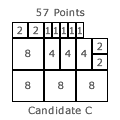
Conclusions & General
For an overview of ranked ballot and party-list CHPV, proceed to the Conclusions chapter.
As well as the six chapters above and the two appendices below, there are some general pages. These include a Glossary, Revision Log, Author & Contact Details, Site Guide and Map. Free spreadsheets for ranked ballot and party-list CHPV elections are also available.
To access these general pages, proceed to the General table of contents.
Evaluations (Ranked Ballot)
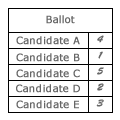
How good or fair is ranked ballot GV? Are reasonable criteria met? How does the half or other ratio between adjacent weights affect the results? If voters or parties attempt to manipulate election outcomes, what happens? With supporting figures, this chapter addresses these topics at an intermediate level. Optional links to mathematical proofs are provided.
For an assessment of ranked ballot CHPV and GV, proceed to the Evaluations (Ranked Ballot) chapter.
Evaluations (Party-List)

Can reasonable proportionality be achieved using party-list CHPV? What proportion of all possible outcomes are optimal? How does proportionality vary with the number of winners and competing parties? With supporting figures, this chapter addresses these topics at an intermediate level. Optional links to mathematical proofs are provided.
For an assessment of party-list CHPV, proceed to the Evaluations (Party-List) chapter.
Comparisons (Single-Winner)
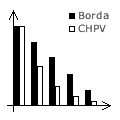
At its extremes, ranked ballot GV is equivalent to the Borda Count and First-Past-The-Post voting systems. As CHPV is mid-way between these extremes, how does it compare? With supporting figures, this intermediate level chapter compares ranked ballot CHPV with these and various other systems. Optional links to mathematical proofs are provided.
For comparisons with other single-winner methods, proceed to the Comparisons (Single-Winner) chapter.
Comparisons (Multiple-Winner)
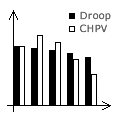
How does CHPV compare to other 'Highest Averages' or 'Largest Remainder' party-list methods or to the Single Transferable Vote regarding the optimality and proportionality of election outcomes? With supporting figures, this intermediate level chapter compares these various rival systems. Optional links to mathematical proofs are provided.
For comparisons with other multiple-winner systems, proceed to the Comparisons (Multiple-Winner) chapter.
Map Construction
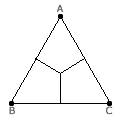
Stick diagrams and multiple-party maps are included in the four intermediate level Evaluations and Comparisons chapters to aid the understanding of otherwise complex issues without the need to appreciate the underlying mathematics. However, optional advanced level technical details are given in this appendix.
To understand how to produce multiple-party maps, proceed to the Map Construction table of contents.
Mathematical Proofs
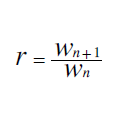
Mathematical proofs are distinct from, but directly linked to, the relevant intermediate level text and supporting figures. This advanced level appendix is for psephologists, mathematicians and peer reviewers.
Voters require no knowledge of mathematics. Except for basic arithmetic, neither do election staff.
To view any proof, proceed to the Mathematical Proofs table of contents.
